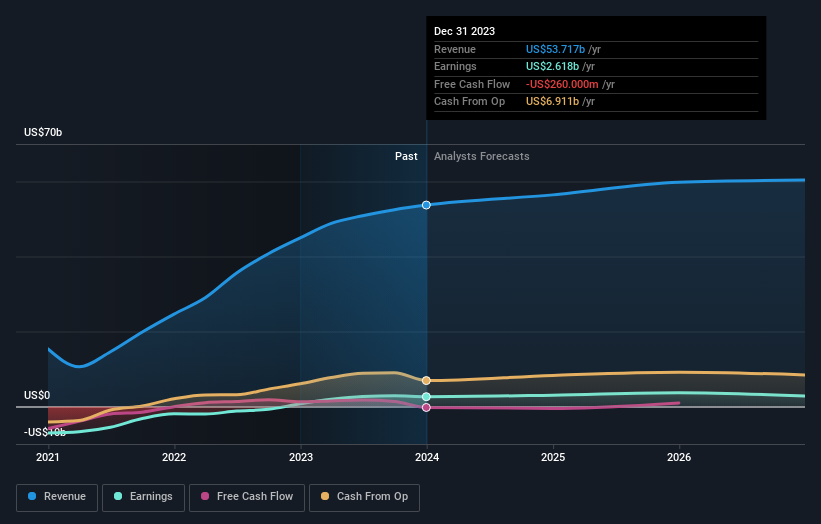- United States
- /
- Airlines
- /
- NasdaqGS:UAL
Here's What Analysts Are Forecasting For United Airlines Holdings, Inc. (NASDAQ:UAL) After Its Yearly Results

Investors in United Airlines Holdings, Inc. (NASDAQ:UAL) had a good week, as its shares rose 4.0% to close at US$40.49 following the release of its annual results. Results were roughly in line with estimates, with revenues of US$54b and statutory earnings per share of US$7.89. Following the result, the analysts have updated their earnings model, and it would be good to know whether they think there's been a strong change in the company's prospects, or if it's business as usual. With this in mind, we've gathered the latest statutory forecasts to see what the analysts are expecting for next year.
Check out our latest analysis for United Airlines Holdings

Taking into account the latest results, the most recent consensus for United Airlines Holdings from 18 analysts is for revenues of US$56.4b in 2024. If met, it would imply a satisfactory 5.1% increase on its revenue over the past 12 months. Statutory earnings per share are predicted to climb 14% to US$9.11. Yet prior to the latest earnings, the analysts had been anticipated revenues of US$56.5b and earnings per share (EPS) of US$9.14 in 2024. So it's pretty clear that, although the analysts have updated their estimates, there's been no major change in expectations for the business following the latest results.
It will come as no surprise then, to learn that the consensus price target is largely unchanged at US$60.90. Fixating on a single price target can be unwise though, since the consensus target is effectively the average of analyst price targets. As a result, some investors like to look at the range of estimates to see if there are any diverging opinions on the company's valuation. Currently, the most bullish analyst values United Airlines Holdings at US$98.00 per share, while the most bearish prices it at US$35.00. With such a wide range in price targets, analysts are almost certainly betting on widely divergent outcomes in the underlying business. With this in mind, we wouldn't rely too heavily the consensus price target, as it is just an average and analysts clearly have some deeply divergent views on the business.
Taking a look at the bigger picture now, one of the ways we can understand these forecasts is to see how they compare to both past performance and industry growth estimates. We can infer from the latest estimates that forecasts expect a continuation of United Airlines Holdings'historical trends, as the 5.1% annualised revenue growth to the end of 2024 is roughly in line with the 5.8% annual growth over the past five years. Compare this with the broader industry (in aggregate), which analyst estimates suggest will see revenues grow 7.5% annually. So it's pretty clear that United Airlines Holdings is expected to grow slower than similar companies in the same industry.
The Bottom Line
The most obvious conclusion is that there's been no major change in the business' prospects in recent times, with the analysts holding their earnings forecasts steady, in line with previous estimates. On the plus side, there were no major changes to revenue estimates; although forecasts imply they will perform worse than the wider industry. The consensus price target held steady at US$60.90, with the latest estimates not enough to have an impact on their price targets.
With that said, the long-term trajectory of the company's earnings is a lot more important than next year. We have forecasts for United Airlines Holdings going out to 2026, and you can see them free on our platform here.
Don't forget that there may still be risks. For instance, we've identified 2 warning signs for United Airlines Holdings that you should be aware of.
New: AI Stock Screener & Alerts
Our new AI Stock Screener scans the market every day to uncover opportunities.
• Dividend Powerhouses (3%+ Yield)
• Undervalued Small Caps with Insider Buying
• High growth Tech and AI Companies
Or build your own from over 50 metrics.
Have feedback on this article? Concerned about the content? Get in touch with us directly. Alternatively, email editorial-team (at) simplywallst.com.
This article by Simply Wall St is general in nature. We provide commentary based on historical data and analyst forecasts only using an unbiased methodology and our articles are not intended to be financial advice. It does not constitute a recommendation to buy or sell any stock, and does not take account of your objectives, or your financial situation. We aim to bring you long-term focused analysis driven by fundamental data. Note that our analysis may not factor in the latest price-sensitive company announcements or qualitative material. Simply Wall St has no position in any stocks mentioned.
About NasdaqGS:UAL
United Airlines Holdings
Through its subsidiaries, provides air transportation services in North America, Asia, Europe, Africa, the Pacific, the Middle East, and Latin America.
Proven track record and slightly overvalued.
Similar Companies
Market Insights
Community Narratives




